Dire wolves vs sabre-tooth tigers: When the megafauna died, who went first?
New research overturns the idea that more ecologically unique species are the most vulnerable.
Woolly mammoths, sabre-tooth tigers, the enormous armadillo-like Glyptodon and the fearsome dire wolves, as seen in Game of Thrones, all roamed the US and Canada in the past 50,000 years. They died in the megafaunal extinction in the Pleistocene period, and now scientists have dispelled an established theory of what factors made them vulnerable – it turns out that the animals' ecological uniqueness played no role in the extinctions.
Scientists have argued about why the extinctions happened, but not many have looked at how. A popular theory has been that the largest and most ecologically unique animals were the first to go. Now a study in the journal Proceedings of the Royal Society B finds otherwise. While size did affect whether an animal went extinct, their ecological uniqueness wasn't a factor.
"We didn't have data at a fine enough scale to ask this question before," study author Matt Davis of Aarhus University in Denmark told IBTimes UK. "We know we had woolly mammoths and things, but most of the time we didn't know exactly which species were around and when."
The key was trudging through a lot of books and museum collections to find the best dates for the extinctions of the North American megafauna, which hadn't been done on this scale.
The findings came as a surprise, as the giant mammals of the continent did not die in the expected order, from most to least ecologically unique.
"They don't seem to go extinct in any order," Davis said. "The most unique ones were just as likely to go extinct as the least unique ones. We couldn't tell any difference from just randomly making species go extinct."
On one view, this is a positive finding for future extinctions: the most unique animals still living aren't necessarily going to be the first ones to go in the ongoing Sixth Mass Extinction.

However on the other hand, the large mammals left in North America are in a very different situation to those in the Pleistocene, Davis said.
"What we see now is that species are really functionally isolated. They don't have close neighbours any more. So if they go extinct, there's nothing filling that niche space any more."
If the giant anteater goes extinct, for instance, there is nothing to fill the vacuum of a large, tree-climbing mammal that eats ants. So when large animals do die out, a large degree of the diversity of mammals is lost – the species left are more similar to each other, and they're also smaller.
As a result, extinctions today are likely to have a much bigger impact on the reduction in diversity of large mammals than prehistoric extinction events did.

© Copyright IBTimes 2025. All rights reserved.






















